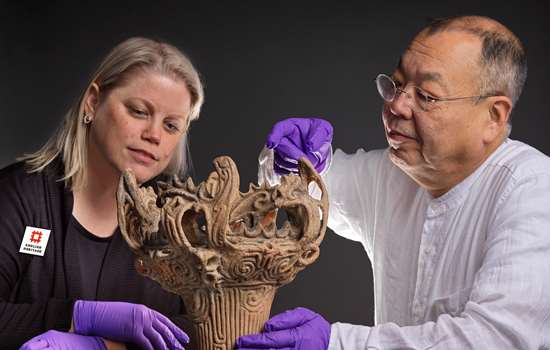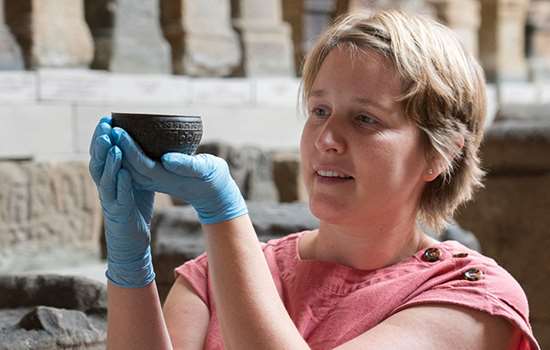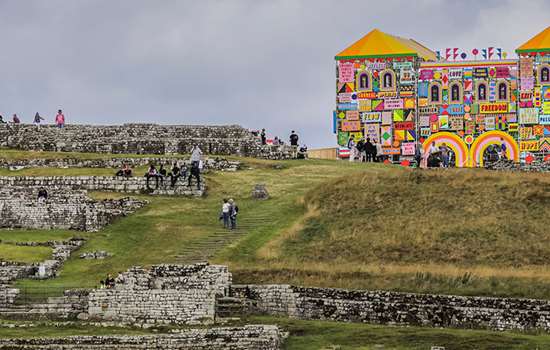28/03/2019
15th century painting confirmed as Botticelli
Madonna of the Pomegranate will be on display at Ranger’s House in Greenwich from 1 April
A painting long thought to be a later imitation of Sandro Botticelli’s famous Madonna of the Pomegranate has been revealed to be a rare example by the artist’s own workshop, English Heritage has revealed today.
The discovery was made while the painting was being cleaned by the charity’s conservators. The work’s true colours – hidden under more than a century of yellow varnish – will be revealed when it goes on display at Ranger’s House in Greenwich on 1 April.
Bought by diamond magnate Julius Wernher in 1897, Madonna of the Pomegranate (Madonna della Melagrana) (c.1487) is the closest version of the famous masterpiece by the Florentine master Botticelli, now in the Uffizi Gallery in Florence, Italy.
Showing the Madonna and Christ Child flanked by four angels, the title refers to the pomegranate that is held by the Madonna and Child to symbolize Christ’s future suffering.
The assumption that the painting was a later imitation arose because of its variations in detail to the original and the thick yellow varnish that concealed the quality of the work. However, x-ray testing, infrared studies and pigment analysis have revealed that the painting is from the very workshop in Florence where Botticelli created his masterpieces.
'Too similar to be an imitation'
Rachel Turnbull, English Heritage’s Senior Collections Conservator, said:
'Being able to closely examine and conserve this painting for the first time in over 100 years has really given us the chance to get up-close and personal with the paintwork. I noticed instantly that the painting bore a striking resemblance to the workshop of Botticelli himself; stylistically it was too similar to be an imitation, it was of the right period, it was technically correct and it was painted on poplar, a material commonly used at the time.
'After removing the yellowing varnish, x-ray and infrared examination revealed under-drawing, including changes to the final composition uncommon in straight imitations. After consultations with our colleagues at the Victoria and Albert Museum and the National Gallery London, we are finally able to confirm that Madonna of the Pomegranate is from the Florentine workshop of master painter Sandro Botticelli.'
About Sandro Botticelli
Running a successful workshop in Florence from 1470, Alessandro Filipepi, known as Sandro Botticelli (1445-1510), employed a number of assistants who would execute large parts or even whole panels of his paintings to help him meet demand.
It was not unusual for popular paintings by Botticelli to be commissioned again by other patrons, but these were often reduced in size, composition or detail by the master and his workshop assistants to fit a smaller budget.
This is the case in this tondo (a kind of circular painting), which is the closet copy of the original. It is painted in exquisite detail with gold leaf adorning Mary’s halo and the wings of the angels flanking her on either side. The angels worship the Madonna and child with lilies (a symbol of Mary’s purity and virginity) and garlands of roses (a symbol of Mary’s love of God) whilst holding books of prayer.
Conservators from English Heritage have removed the surface dirt, the 19th-century overpaint and old varnish to reveal the paintings’ true quality with its vivid reds, blues and golds.
See the masterpiece for yourself
The painting will go back on display at Ranger’s House, an elegant Georgian villa in Greenwich Park that showcases the exceptional craftsmanship of working artists across Europe. It's home to the Wernher Collection – an assortment of over 700 works of fine and decorative art amassed by diamond magnate Julius Wernher in the late 19th century.
It houses ornate medieval jewellery, Gothic sculptures, Italian ceramics, Renaissance paintings, eighteenth-century French furniture and British portraits.
Madonna of the Pomegranate will go on display when Ranger’s House reopens to the public on Monday 1 April.
Find out more and visit Ranger's House.
Discover the history of Ranger's House.
For more from English Heritage, follow us on Facebook, Twitter and Instagram.



